SONS
OF DEWITT COLONY TEXAS Flags of Texas Independence Movements For More on Topics and Biographies, Search Handbook of Texas Online "The Texans flatter themselves--they have a government and are fighting under no recognized flag."--Santa Anna
Edwards proceeded to force settlers, both Anglo and native Hispanics, to move or pay him for their land. The Mexican government canceled his contract. In response to the cancellation, Edwards made an alliance with Cherokee Indians represented by John Dunn Hunter and Richard Fields and declared the "Republic of Fredonia" independent of Mexico under the banner shown. The two colors are thought to symbolize the alliance. Inscribed also in the white field were names of key participants in the alliance. After he failed to rally a significant number of Anglo settlers in the Austin, DeWitt, DeLeon colonies and other areas of Texas, he abandoned the cause and returned to the United States. The flag was said to have been displayed later at rallies for Texas independence in 1835.
According to Creed Taylor in Tall Men with Long Rifles, this flag was "of ordinary solid color 'calico'-tri-colored, red, white and blue, emblazoned with a five-pointed white star, set in the red background, the three color bars being set perpendicular, or upright, the red, with the star next to the flagstaff......was much in evidence on the march from Gonzales to San Antonio, being borne by Second Lieutenant James Ferguson. I remember seeing this flag at our camp on the Cibolo, and I think it was carried on to Concepcion....I have heard it was left in the Alamo....and that fragments...were found among the ruins after the fall of the fortress." Guy M. Bryan in a speech before the Texas Veterans Association in 1873 "The first Lone Star flag that I can find account of was made at Harrisburgh in this county, and presented to the company of Captain Andrew Robinson in 1835. The Lone Star was white, five pointed, and set in a ground of red." Historian John Henry Brown states that this banner was flown at the Texas Independence Convention at Washington-on-the-Brazos beginning 1 March 1836 before the fall of the Alamo. This flag employing red, white and blue stripes with the single star is the earliest flag most similar in color and number of stripes to the Lone Star flag of today while retaining the broad vertical stripes similar to the motif of the Mexican tri-color. Absent was the color green and other symbols of the Mexican Republic.
Mrs. M. Looscan (daughter of Capt. Andrew Briscoe) in Wooten's Comprehensive History of Texas relates the description of its origin as told by veteran James L. McGahey: "the flag was suggested by Capt. William Scott, who lived a short distance below Lynchburg and at whose place a company was being raised and equipped, of which Scott was elected Captain. He gave to Mr. McGahey about 4 yards of solid blue silk; the latter took it to Lynchburg to procure a staff from the sawmill; while there Mrs. John Lynch sewed a piece of domestic to the silk to prevent the fraying from contact with the staff, and Charles Lanco, an Italian, painted a large white star in the centre with with the word Independence below." Mrs. Looscan related that conservatives objected to flying the flag from the time it was unfurled by the company on their march to Gonzales in Oct 1835 to join Austin's Texian Federal Army which was being organized there. In the presence of Stephen F. Austin the flag was kept unfurled by James McGahey in his knapsack, but thought to be displayed at the Grass Fight and on 28 Oct 1835 at Concepcion. Legend says McGahey was wounded and gave the banner to Thomas H. Bell who may have carried it in the Siege and Battle of Bexar in Dec 1835. Bell returned to Goliad with Capt. Dimmitt's troops where the banner may have flown with others upon signing of the Goliad Declaration of Independence. Bell was with the group who carried the Goliad Declaration to San Felipe and the flag, in addition to Capt. Brown's bloody arm flag below, is said to have been raised there. [According to a Zanco family researcher, Charles Lanco refers to Charles Zanco whose father was Italian and mother Danish. He was born in Denmark and came to Texas with his father after death of his mother. Zanco initially joined Scott's company and was later a member and casualty of the Alamo garrison and battle under Travis and Bowie. Zanco was a Lieutenant and assistant to the ordnance chief--WLM, ed.]
There it may have been flown in front of the American Hotel on 8 Jan 1836 along with the Troutman flag of the Georgia Battalion. Author John Henry Brown (History of Texas) stated "Over the cabin in which the convention met and declared for independence, floated a flag with the design of a sinewy hand grasping a red sword, and underneath this was a lone star flag." Mamie Wynne Cox in Romantic Flags of Texas says "As Captain Brown's Flag was the only banner carrying a design of a bloody sword, this could have been none other than his." Cox describes the Brown flag as a large deep blue field in the upper left corner, in which is a white arm grasping a sword fromt he point of which is dripping blood. The flag has thirteen stripes, seven red and six white with the word INDEPENDENCE in the third white stripe from the top. Author Brown's description does not clearly describe either of the two "bloody arm" flags or the lone star flag. He appears to be referring to two flags on the same pole, although it could even have been a composite single banner. (Image adapted from Gilbert, Flags of Texas)
Which banner was actually flown over the Goliad garrison is the subject of controversy and comment by historians. Mary Agnes Mitchell in First Flag of Texas Independence cites memoirs of participants John James and Nicholas Fagan "The Goliad flag was made personally by Captain Dimmitt himself....It was of white domestic, two yards in length and one in width, and in the center was a sinewy arm and hand, painted red, grasping a drawn sword of crimson.....The flagpole was made from a tall sycamore which was procured from the woods along the banks of the San Antonio River.....The flagstaff was in the yard of the quadrangle opposite the entrance to the officers' quarters." Dimmitt's flag flew over the ramparts of Goliad through 10 Jan 1836 when Dr. James Grant and the Federalist Volunteers of Texas forced its removal with threat of violence and which caused the subsequent exit of Col. Dimmitt and those loyal to him from the garrison. The banner is thought to have exited with them. The motivation behind Dimmitt's use of the bloody arm symbol is unclear as was whether he acquired it independently or simply under influence of the Brown flag which employed the same symbol (see Origin of the Bloody Arm Symbol).
On one side was the words Ubi libertas habitat ibi nostra patria est--"Where Liberty Dwells, There is my Home" in Latin, on the other side was the letters indicated. Author John Henry Brown says that the flag was flown at the American Hotel in Velasco in Jan 1836 upon the arrival of the Georgia Battalion in Texas and some have claimed it also flew at the Texas Independence convention at Washington-on-the-Brazos. However, it was said to have been taken to and flown at Goliad by Col. Fannin. Guy M. Bryan in a speech before the Texas Veterans Association in 1873 "The Georgia battalion flag was azure, lone star, five points, in white field. This flag was raised as national flag on the walls of Goliad by Fannin when he heard of the Declaration of Independence." The flag was thought to have been destroyed in haste to get it down upon retreat from the garrison at Goliad.
It was dubbed the San Felipe flag and based on ideas expressed to Gail Borden Jr. by Stephen F. Austin in the enclosure to a letter from New Orleans of 18 Jan 1836: "I shall preach independence all over the US wherever I go--What do you think of the inclosed idea of a flag." The flag was presented to the company of volunteers commanded by Captain Moseley Baker (John P. Borden, 1st. Lt.) by Gail Borden Jr. in the name of "two ladies" from the area as they marched from San Felipe 29 Feb 1836 for Gonzales. Capt. Baker made a speech to his company in response to the presentation referring to the flag "this banner of independence." He said "first in your hands is placed the Texas flag; let you be the last to see it strike to the invading foe! Let no other feeling ever glow in your bosom than that expressed in the motto on your banner, 'Our Country's Rights or Death.'.....Let us all raise our hands to heaven and swear, 'The Texas flag shall wave triumphant or we will sleep in death!'" It was claimed to have been flown at San Jacinto by those in Sherman's division. (Modified from Gilbert, Flags of Texas).
Flying the flag, Sherman's regiment met Gen. Houston in Gonzales after the Alamo defeat and followed him into the Battle of San Jacinto. In Aug 1836, the flag was returned to Mrs. Sherman at Frankfort, KY with a letter: "Velasco, August 5, 1836, War Department. This stand of colors, presented by the ladies of Newport, Kentucky, to Captain Sidney Sherman, is the same which triumphantly waved on the memorable field of San Jacinto, and is by the government presented to the lady of Colonel Sidney Sherman as a testimonial of his gallant conduct on that occasion. A. Somerville (signed), Secretary of War. Approved: David G. Burnet." The flag was kept by the family for many years and later returned to the State of Texas in a ceremony in the House of Representatives in 1933. It was placed in custody of the Daughters of the Texas Revolution. The above artist's depiction is thought to be close to the original banner brought from Kentucky. The banner on the sword says "Liberty or Death." Over the years, artist's renditions and historical narratives describing the flag vary in the clothing on the upper body of Liberty. Wooten's color plate depicting the flags of Texas in his Comprehensive History of Texas in 1898 show an out of focus, diffuse, fully-clothed Liberty similar to the Statue of Liberty in New York. The rendition in Gilbert's 1968 edition of A Concise History of Early Texas: As told by its 30 historic flags depict Liberty's upper torso fully covered with a transparent blouse while the 1994 edition shows the depiction above. Attempts at restoration of the original banner are also thought to have altered the details of Liberty's clothing. The original flag was placed in a glass case behind the Speaker's podium in the House of Representatives in Austin. Reportedly insignia on the banner is barely detectable due to fading during storage and display over the years and the actual flag is only displayed from the backside which where an image is more discernable when the House is in session. (Image modified from C. E. Gilbert, A Concise History of Early Texas: As told by its 30 historic flags)
SONS OF DEWITT
COLONY TEXAS |
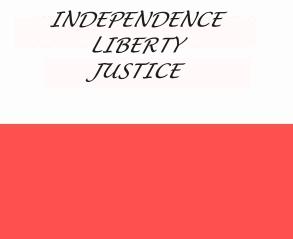 Flag of the
Flag of the 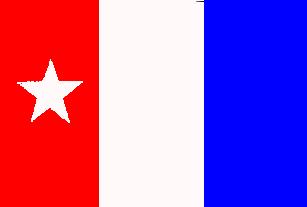 Flag of the Harrisburg Volunteers. This banner was carried by volunteers comprising Capt. Andrew Robinson's company
from Harrisburg and designed by Sarah Rudolph Bradley Dodson in Sep 1835 for her husband,
1st Lt. A.B. Dodson and colleagues. Mrs. M. Looscan in her article in Wooten's
Comprehensive History of Texas, who claimed her information came from Mr. Dodson who
was still living in Alice, NuecesCo, TX in 1896, describes the red, white and blue flag at
left, but with the star, said to be copied from an old military coat button or seal, in a
blue field next to the staff. According to Dodson she related that the flag was flown by
the company in the Siege and Battle of Bexar.
Flag of the Harrisburg Volunteers. This banner was carried by volunteers comprising Capt. Andrew Robinson's company
from Harrisburg and designed by Sarah Rudolph Bradley Dodson in Sep 1835 for her husband,
1st Lt. A.B. Dodson and colleagues. Mrs. M. Looscan in her article in Wooten's
Comprehensive History of Texas, who claimed her information came from Mr. Dodson who
was still living in Alice, NuecesCo, TX in 1896, describes the red, white and blue flag at
left, but with the star, said to be copied from an old military coat button or seal, in a
blue field next to the staff. According to Dodson she related that the flag was flown by
the company in the Siege and Battle of Bexar. 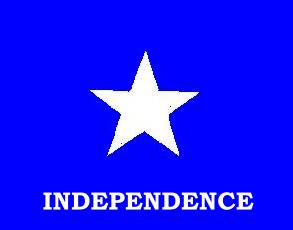 Scott's Flag
of the Liberal Faction. As dictatorial acts contrary to the liberal
Mexican Constitution of 1824 by the centralista dictatorship began to mount, the number of
Texans known as the Liberal Faction or War Party increased while the Conservatives rallied
under the Mexican flags of 1824 hoping for a peaceful settlement with their adopted
government and a return to the principles of local self-determination. This banner was
apparently the earliest symbol of those who had abandoned hopes for reconciliation. A
banner of similar color and design without the lettering was first used in 1810 when
American frontiersmen rebelled against Spanish authorities at Baton Rouge in Spanish West
Florida. Although never official, this design became famous as "The Bonnie
Blue Flag" symbol in the Confederate States of America after secession in 1861.
Scott's Flag
of the Liberal Faction. As dictatorial acts contrary to the liberal
Mexican Constitution of 1824 by the centralista dictatorship began to mount, the number of
Texans known as the Liberal Faction or War Party increased while the Conservatives rallied
under the Mexican flags of 1824 hoping for a peaceful settlement with their adopted
government and a return to the principles of local self-determination. This banner was
apparently the earliest symbol of those who had abandoned hopes for reconciliation. A
banner of similar color and design without the lettering was first used in 1810 when
American frontiersmen rebelled against Spanish authorities at Baton Rouge in Spanish West
Florida. Although never official, this design became famous as "The Bonnie
Blue Flag" symbol in the Confederate States of America after secession in 1861.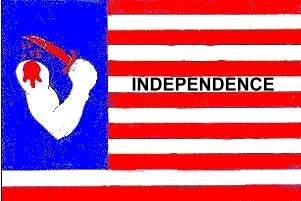 Brown's Flag
of Independence. This flag is said to have been
designed by Capt. William S. Brown at Velasco in fall 1835 preceding
Brown's Flag
of Independence. This flag is said to have been
designed by Capt. William S. Brown at Velasco in fall 1835 preceding 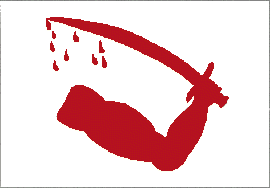 Dimmit's
Goliad Flag. This militant and defiant banner, designed by Goliad
garrison commander, Capt. Phillip Dimmitt, dramatically reflected the political shift of
Texians and Capt. Dimmitt away from support of the independent statehood of Texas in the
Mexican Federalist Republic and return to the Constitution of 1824 to support of complete
separation from Mexico as an independent Republic. Before he returned from the Siege and
Battle of Bexar to Goliad in the middle of Dec 1835, Capt. Dimmitt was an avid Mexican
Federalist and opposed to separation which was symbolized in the
Dimmit's
Goliad Flag. This militant and defiant banner, designed by Goliad
garrison commander, Capt. Phillip Dimmitt, dramatically reflected the political shift of
Texians and Capt. Dimmitt away from support of the independent statehood of Texas in the
Mexican Federalist Republic and return to the Constitution of 1824 to support of complete
separation from Mexico as an independent Republic. Before he returned from the Siege and
Battle of Bexar to Goliad in the middle of Dec 1835, Capt. Dimmitt was an avid Mexican
Federalist and opposed to separation which was symbolized in the 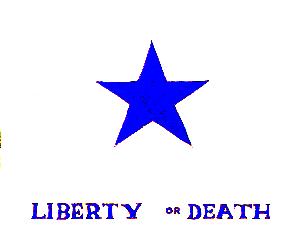 Troutman Goliad Flag. This flag was designed in
Nov 1835 by Johanna Troutman, sometimes called the Betsy Ross of
Texas. When the Georgia Battalion of Volunteers under Captain William Ward marched from
Macon to Columbus, GA on their way to Texas in response to an appeal for aid for Texas by
Col. Fannin, Miss Troutman (daughter of Col. C.A. Troutman of Knoxville, GA and later Mrs.
Pope), presented the troop with the flag to carry with them. According to Mrs. Looscan,
the banner was of white silk with an azure star on both sides.
Troutman Goliad Flag. This flag was designed in
Nov 1835 by Johanna Troutman, sometimes called the Betsy Ross of
Texas. When the Georgia Battalion of Volunteers under Captain William Ward marched from
Macon to Columbus, GA on their way to Texas in response to an appeal for aid for Texas by
Col. Fannin, Miss Troutman (daughter of Col. C.A. Troutman of Knoxville, GA and later Mrs.
Pope), presented the troop with the flag to carry with them. According to Mrs. Looscan,
the banner was of white silk with an azure star on both sides. 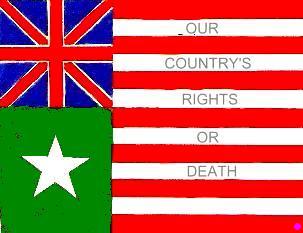 Baker's Flag of San Felipe. According to the Telegraph and Texas Register, San Felipe, 5 Mar 1836 "....the
English Jack showing the origin of Anglo-Americans, thirteen stripes representing that
most of the colonists in Texas are from the United States; the Star is Texas, the only
state in Mexico retaining the least spark of the light of Liberty; tricolor is Mexican,
showing that we onced belonged to the confederacy; the whole flag is historic."
Baker's Flag of San Felipe. According to the Telegraph and Texas Register, San Felipe, 5 Mar 1836 "....the
English Jack showing the origin of Anglo-Americans, thirteen stripes representing that
most of the colonists in Texas are from the United States; the Star is Texas, the only
state in Mexico retaining the least spark of the light of Liberty; tricolor is Mexican,
showing that we onced belonged to the confederacy; the whole flag is historic." 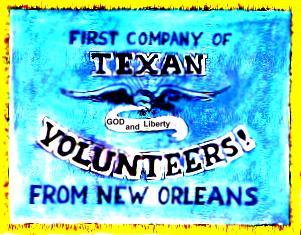 Flag of the New Orleans Greys. Two groups of volunteers from New Orleans joined the Texas resistance to the
Mexican centralista dictatorship. Members of the Greys participated in the
Flag of the New Orleans Greys. Two groups of volunteers from New Orleans joined the Texas resistance to the
Mexican centralista dictatorship. Members of the Greys participated in the  Flag of the
Flag of the 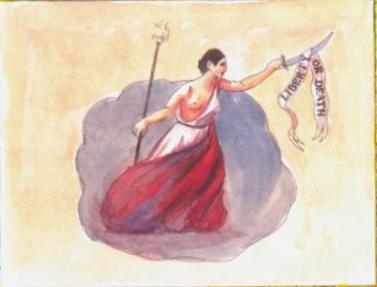 San Jacinto Liberty Flag of Sherman's Volunteers from Newport,
Kentucky. Although there was no single banner
representing the Texian Army at the time, of those that were probably displayed, this flag
is most commonly associated with the Battle of San Jacinto. This banner was presented to
Sherman's Newport Volunteers upon their departure for Texas by the ladies of Newport,
Kentucky. Capt. Sherman's new bride, Katherine Isabel Cox, was chosen to make the
presentation. Thousands are said to have waved the company off as they departed by steamer
from Cincinnatti on the Ohio River. Legend says that
San Jacinto Liberty Flag of Sherman's Volunteers from Newport,
Kentucky. Although there was no single banner
representing the Texian Army at the time, of those that were probably displayed, this flag
is most commonly associated with the Battle of San Jacinto. This banner was presented to
Sherman's Newport Volunteers upon their departure for Texas by the ladies of Newport,
Kentucky. Capt. Sherman's new bride, Katherine Isabel Cox, was chosen to make the
presentation. Thousands are said to have waved the company off as they departed by steamer
from Cincinnatti on the Ohio River. Legend says that 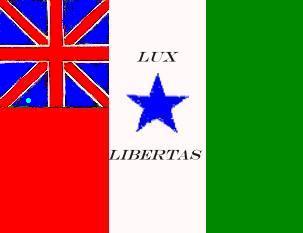 Suggested
Independence Flags of Austin, Wharton and Archer. After the
Suggested
Independence Flags of Austin, Wharton and Archer. After the 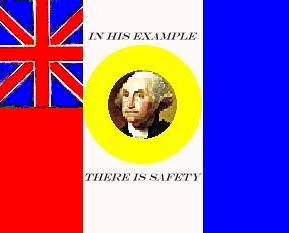 At the convention in November 1835, despite intense debate, the objective
remained independent statehood in a Federal Mexican Republic under the Constitution of
1824 rather than a full declaration of independence as a sovereign Republic. Most prepared
for the latter and the seemingly inevitable impending war. Others saw that long term
independence might require the overt protection of the United States and eventual
annexation. Wharton and Archer insisted on replacement of the Mexican green stripe with
union blue. Moreover, they suggested a sun rather than the star with George Washington's
head in the center and the words shown in the banner at left. In a letter to her brother
Stephen Austin in New Orleans of 1 Jun 1836, Mary Austin Holley wrote from Lexington,
Texas "Miss James has painted your flag on silk--Sun Washington and all--it is
beautiful--it is to be presented by Henrietta--with an appropriate speech written for her
by myself--Friday afternoon--How interesting to have you here! It is to be in Mrs. Harts
lawn....All the military were to parade....I furnished the silk for the flag--Gen. McCalla
the Staff and spear head."
At the convention in November 1835, despite intense debate, the objective
remained independent statehood in a Federal Mexican Republic under the Constitution of
1824 rather than a full declaration of independence as a sovereign Republic. Most prepared
for the latter and the seemingly inevitable impending war. Others saw that long term
independence might require the overt protection of the United States and eventual
annexation. Wharton and Archer insisted on replacement of the Mexican green stripe with
union blue. Moreover, they suggested a sun rather than the star with George Washington's
head in the center and the words shown in the banner at left. In a letter to her brother
Stephen Austin in New Orleans of 1 Jun 1836, Mary Austin Holley wrote from Lexington,
Texas "Miss James has painted your flag on silk--Sun Washington and all--it is
beautiful--it is to be presented by Henrietta--with an appropriate speech written for her
by myself--Friday afternoon--How interesting to have you here! It is to be in Mrs. Harts
lawn....All the military were to parade....I furnished the silk for the flag--Gen. McCalla
the Staff and spear head."